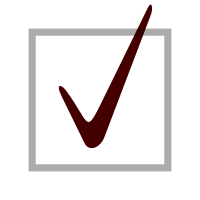Check mark

A tick (known as a check mark or check in Canadian and American English) is a mark (✓, ✔, ☑, etc.) used to indicate the concept "yes", for example "yes; this has been verified" or, "yes; that is the correct answer". The x mark is also sometimes used for this purpose (most notably on election ballot papers), but otherwise usually indicates "no", incorrectness, or failure.[citation needed]
As a verb, to tick (off) or to check (off) means to add such a mark. It is quite common, especially on printed forms, printed documents, and computers (see check box), for there to be squares in which to place ticks.
In some European countries[citation needed] (e.g., Finland and Sweden), and in Japan, the tick can be used as an error mark and indicates "no" rather than "yes". In Japan, an "O Mark" (in the appearance of a circle, Unicode symbol "◯"), also known as "丸印" marujirushi, is used instead of a tick to mean "yes"; this symbol is also used in Korea and China.[citation needed] A tick placed in brackets can mean a previously used or acceptable fact or definition is being looked into, usually for the purpose of expanding academic research.[citation needed]
A rainbow-colored tick was also used for the Amiga logo during the Commodore era of the Amiga (1985–1994).
Unicode
Unicode provides various related symbols, including:
| Symbol | Unicode Codepoint (Hex) | Name |
|---|---|---|
| ✓ | U+2713 | CHECK MARK (tick) |
| ✔ | U+2714 | HEAVY CHECK MARK (bold tick) |
| ☐ | U+2610 | BALLOT BOX (square) |
| ☑ | U+2611 | BALLOT BOX WITH CHECK (square with tick) |
